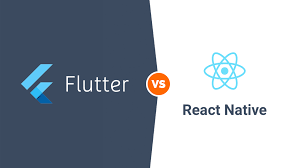Flutter and React Native, two of the top market players and development frameworks, are now in fierce competition to establish their value in the field of cross-platform mobile app development. Finding the framework that best suits an app idea is proving to be very tough for people who want to develop apps more rapidly and for less money.
In order to make this activity a little easier, we have addressed the most important comparative aspects in this post, which will enable you to learn useful information about both options.
What are React Native and Flutter? An Early Look
With the help of the Flutter mobile app SDK, you can create apps for both Android and iOS using a single database. Alternatively, you can use it to create natively built apps for mobile, web, and desktop using a single codebase.
React is a JavaScript framework developed by Facebook that is used to create true native mobile applications for iOS and Android.
When not to choose
Flutter is not the framework you should choose if your app design is platform-specific, requires several OS interactions, has a minimalist UI, and is picky about phone hardware. If your program needs to communicate with the device in a unique way over Bluetooth, perform a challenging work in the background and is intended to run exclusively on Android devices, you should definitely choose react native app development. Since it works well with iOS app development.
Community Assistance
Flutter is still in its infancy with a developing community, while React has grown greatly in popularity due to its earlier launch than Flutter.
Testing Assistance
While using third-party tools like Detox and Appium, the React Native community lacks formal support for UI level testing and integration; in contrast, flutter offers a robust set of testing features including widget testing that make it far superior than React.
Programming Language
React Native is simple to use because it employs JavaScript, a popular programming language among web developers. As opposed to Flutter, which makes use of the less common and infrequently used Dart programming language, it is clear that React is in the lead.
Technology
Flutter, in contrast, to React Native, has all the native components required for app development included within the Flutter Engine or framework itself, improving performance over the latter. React Native uses JavaScript Bridge to interface with the native modules.
User Interface
Because Flutter apps have a single codebase and a component-rich design, they look nice on all OS versions and will behave organically, unlike Native apps, whose application components closely resemble native ones. React can therefore be used if you want your app to essentially look the same on all platforms.
Time to Market
Naturally, React is faster in development than a flutter, but only marginally. It takes longer to design since it uses a bridge and a native component that need to be optimized separately for each platform.
In conclusion, Flutter is still in its infancy but is working hard to improve its reliability, and many apps have been created with it, including the Xianyu app by Alibaba, the Google Ads app, the app for JD Finance, the Hamilton app, etc. And among the well-known applications created with React Native are Instagram, Facebook, Pinterest, Skype, Tesla, Wix, etc. Considering the comparison above, you can likely reckon which framework will suit best for your mobile app development.

